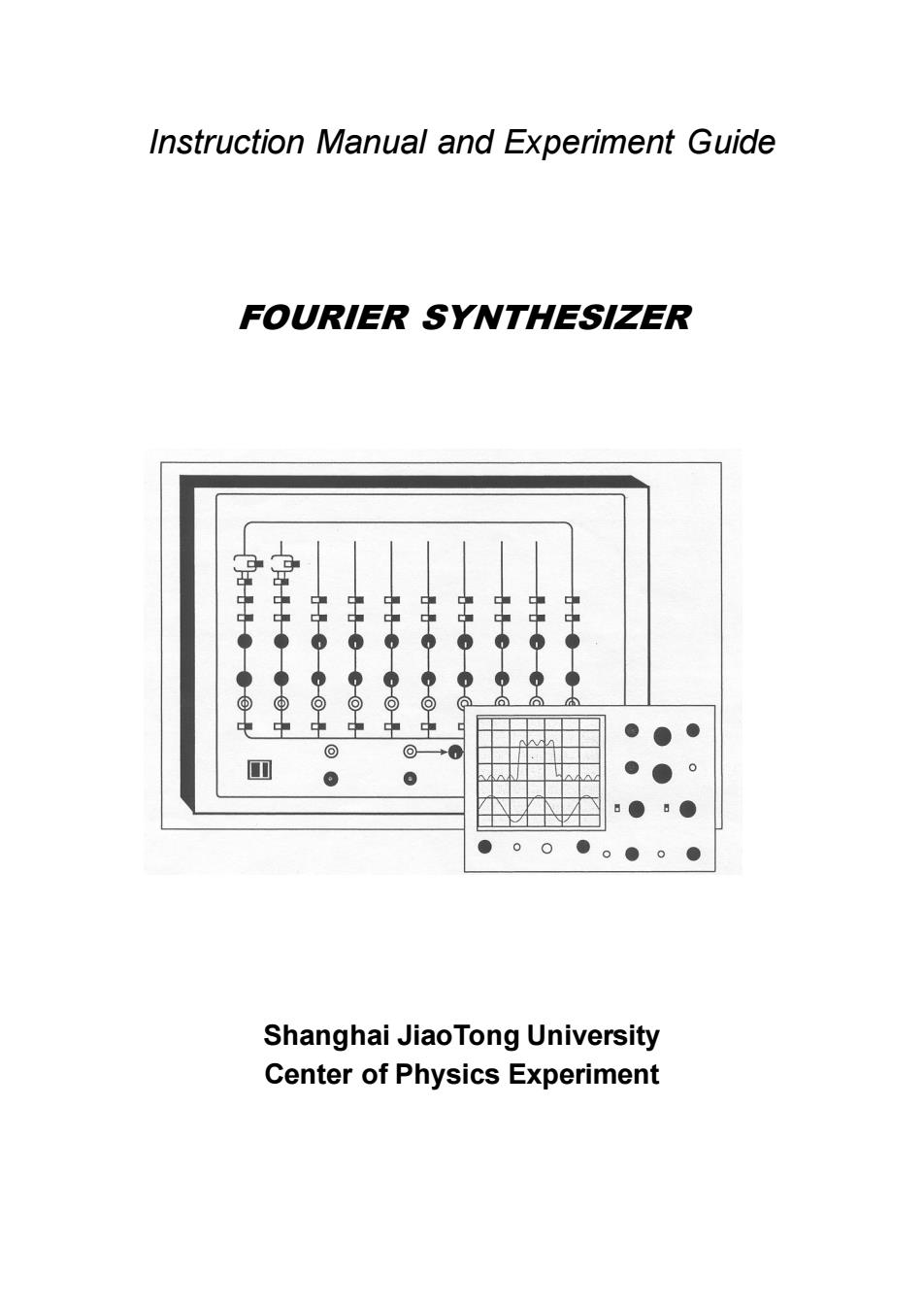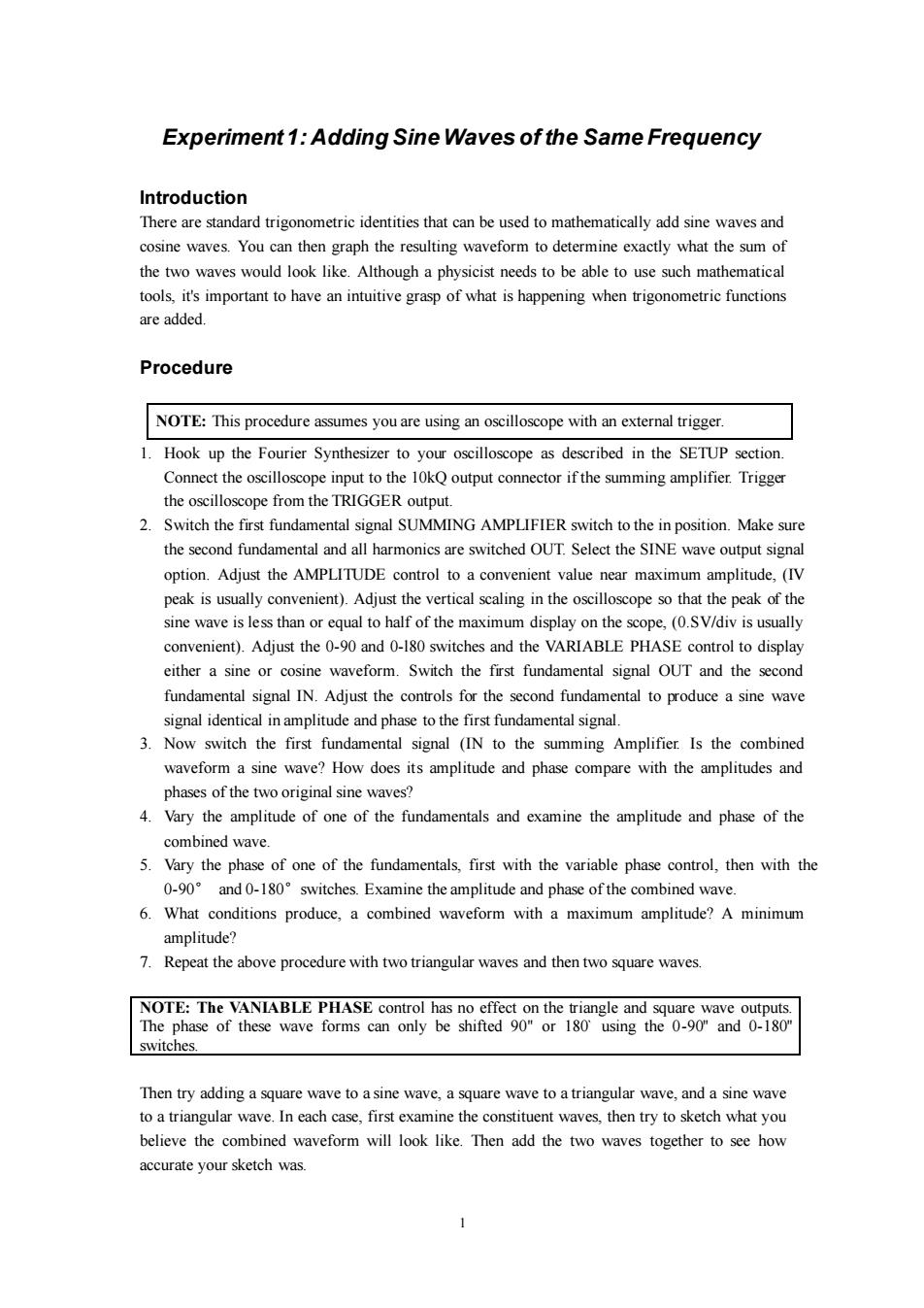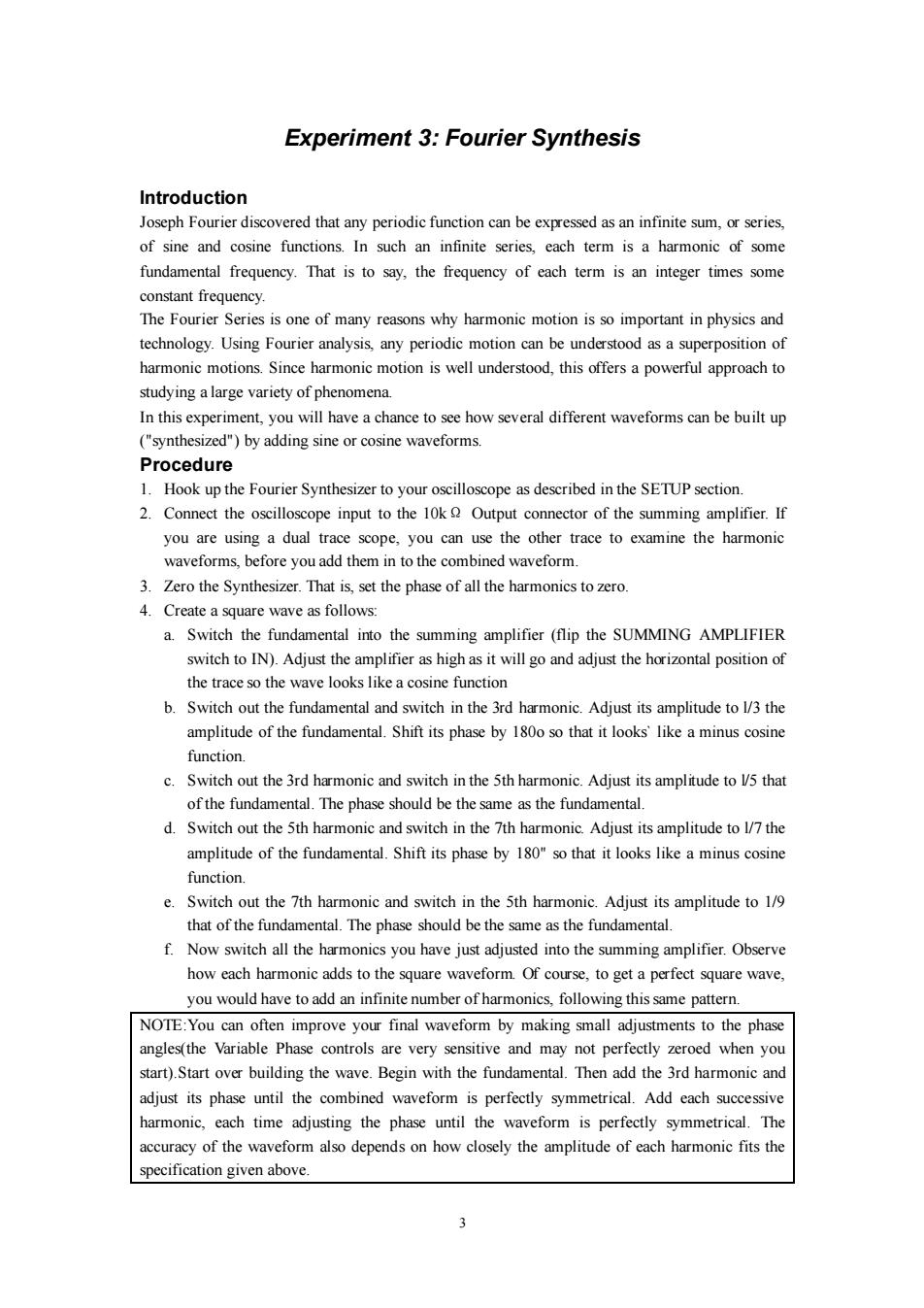
Instruction Manual and Experiment Guide FOURIER SYNTHESIZER 中o 中! 回 回 回 团 Shanghai JiaoTong University Center of Physics Experiment
Instruction Manual and Experiment Guide FOURIER SYNTHESIZER Shanghai JiaoTong University Center of Physics Experiment

Table of contents Section Page Experiment 1:Adding Sine Waves ofthe Same Frequency.............. Experiment2:Adding Sine Waves ofDifferent Frequency............2 Experiment3:Fourier Synthesis............... 3 Experiment4:Gibbs Phenomenon.......................... 5 Experiment 5:Music...... …6 Experiment 6:Lissajous Figures..... P Experiment 7:Interesting Traces...... 9
Table of contents Section Page Experiment 1: Adding Sine Waves of the Same Frequency.…….…..1 Experiment 2: AddingSine Waves of Different Frequency…………2 Experiment 3: Fourier Synthesis…………………………………….3 Experiment 4: Gibbs Phenomenon…………………………………..5 Experiment 5: Music………………………………………………...6 Experiment 6: Lissajous Figures…………………………………….8 Experiment 7: Interesting Traces…………………………………….9

Experiment 1:Adding Sine Waves of the Same Frequency Introduction There are standard trigonometric identities that can be used to mathematically add sine waves and cosine waves.You can then graph the resulting waveform to determine exactly what the sum of the two waves would look like.Although a physicist needs to be able to use such mathematical tools,it's important to have an intuitive grasp of what is happening when trigonometric functions are added. Procedure NOTE:This procedure assumes you are using an oscilloscope with an external trigger 1.Hook up the Fourier Synthesizer to your oscilloscope as described in the SETUP section. Connect the oscilloscope input to the 10kQ output connector if the summing amplifier.Trigger the oscilloscope from the TRIGGER output. 2.Switch the first fundamental signal SUMMING AMPLIFIER switch to the in position.Make sure the second fundamental and all harmonics are switched OUT.Select the SINE wave output signal option.Adjust the AMPLITUDE control to a convenient value near maximum amplitude,(IV peak is usually convenient).Adjust the vertical scaling in the oscilloscope so that the peak of the sine wave is less than or equal to half of the maximum display on the scope,(0.SV/div is usually convenient).Adjust the 0-90 and 0-180 switches and the VARIABLE PHASE control to display either a sine or cosine waveform.Switch the first fundamental signal OUT and the second fundamental signal IN.Adjust the controls for the second fundamental to produce a sine wave signal identical in amplitude and phase to the first fundamental signal. 3.Now switch the first fundamental signal (IN to the summing Amplifier.Is the combined waveform a sine wave?How does its amplitude and phase compare with the amplitudes and phases of the two original sine waves? 4.Vary the amplitude of one of the fundamentals and examine the amplitude and phase of the combined wave. 5.Vary the phase of one of the fundamentals,first with the variable phase control,then with the 0-90 and 0-180 switches.Examine the amplitude and phase of the combined wave. 6.What conditions produce,a combined waveform with a maximum amplitude?A minimum amplitude? 7.Repeat the above procedure with two triangular waves and then two square waves. NOTE:The VANIABLE PHASE control has no effect on the triangle and square wave outputs. The phase of these wave forms can only be shifted 90"or 180 using the 0-90"and 0-180" switches. Then try adding a square wave to a sine wave,a square wave to a triangular wave,and a sine wave to a triangular wave.In each case,first examine the constituent waves,then try to sketch what you believe the combined waveform will look like.Then add the two waves together to see how accurate your sketch was
1 Experiment 1: Adding Sine Waves of the Same Frequency Introduction There are standard trigonometric identities that can be used to mathematically add sine waves and cosine waves. You can then graph the resulting waveform to determine exactly what the sum of the two waves would look like. Although a physicist needs to be able to use such mathematical tools, it's important to have an intuitive grasp of what is happening when trigonometric functions are added. Procedure NOTE: This procedure assumes you are using an oscilloscope with an external trigger. 1. Hook up the Fourier Synthesizer to your oscilloscope as described in the SETUP section. Connect the oscilloscope input to the 10kQ output connector if the summing amplifier. Trigger the oscilloscope from the TRIGGER output. 2. Switch the first fundamental signal SUMMING AMPLIFIER switch to the in position. Make sure the second fundamental and all harmonics are switched OUT. Select the SINE wave output signal option. Adjust the AMPLITUDE control to a convenient value near maximum amplitude, (IV peak is usually convenient). Adjust the vertical scaling in the oscilloscope so that the peak of the sine wave is less than or equal to half of the maximum display on the scope, (0.SV/div is usually convenient). Adjust the 0-90 and 0-l80 switches and the VARIABLE PHASE control to display either a sine or cosine waveform. Switch the first fundamental signal OUT and the second fundamental signal IN. Adjust the controls for the second fundamental to produce a sine wave signal identical in amplitude and phase to the first fundamental signal. 3. Now switch the first fundamental signal (IN to the summing Amplifier. Is the combined waveform a sine wave? How does its amplitude and phase compare with the amplitudes and phases of the two original sine waves? 4. Vary the amplitude of one of the fundamentals and examine the amplitude and phase of the combined wave. 5. Vary the phase of one of the fundamentals, first with the variable phase control, then with the 0-90° and 0-180°switches. Examine the amplitude and phase of the combined wave. 6. What conditions produce, a combined waveform with a maximum amplitude? A minimum amplitude? 7. Repeat the above procedure with two triangular waves and then two square waves. NOTE: The VANIABLE PHASE control has no effect on the triangle and square wave outputs. The phase of these wave forms can only be shifted 90" or 180` using the 0-90" and 0-180" switches. Then try adding a square wave to a sine wave, a square wave to a triangular wave, and a sine wave to a triangular wave. In each case, first examine the constituent waves, then try to sketch what you believe the combined waveform will look like. Then add the two waves together to see how accurate your sketch was

Experiment 2:Adding Sine Waves of Different Frequency Introduction Two sine wave of the same amplitude and phase can be added mathematically using the formula: sin(2 t)+sin(2mv2t)=2cosa(v -v2 )tsin a(v +v2 )t If v and v,are greatly different,then the wave described by the right side of this equation is even more difficult to visualize than the wave described by the left side. However of v and v,are nearly the same,the cosine term will have a much lower frequency than the sine term.Then the wave can be visualized as a sine wave of frequency,with the amplitude of this sine wave varying slowly with a frequency of(v -v,)/2. If this were a sound wave,you would hear what is called beats,the relatively slow pulsing of the tone as the amplitude rises and falls. Procedure NOTE: a.This procedure assumes you are using a dual trace scope with an external trigger. b.A speaker output,in addition to the oscilloscope,is a valuable addition to this lab 1.Hook up the Fourier Synthesizer to your oscilloscope as described in the SETUP section. Connect one of the oscilloscope inputs to the 10k Output connector of the 9th harmonic. Connect the other oscilloscope input to the 10k Output connector of the summed waveform. 2.Switch the 8th harmonic into the summing amplifier.Make sure all the other waveforms are switched out.Examine the 8th and 9th hammonics at the same time.Adjust their amplitudes and phases to the same values. 3.Now add the two waves by switching the 9th harmonic into the summing amplifier(be sure to flip the 0-180 switch at the same time to offset the 180"phase shift caused by the summing amplifier).Describe the resulting waveform.Do you see beats,If so,what is the frequency of the beats?What is the frequency of the modulated wave? 4.Describe what happens as you vary the amplitude or phase ofeither harmonic. 5.Repeat the above steps using different combinations of harmonics,such as the 7th and the 8th, the 7th and the 9th,the,Ist and the 2nd,the 2nd and the 9th.Try any combinations that you think might be interesting.In each case,describe your results.Is the resulting waveform periodic?If so,what is the period?Do beats occur? 6.From your observations,what generalizations can you make about adding sine waves of different frequencies?Under what conditions do you expect beats?
2 Experiment 2: Adding Sine Waves of Different Frequency Introduction Two sine wave of the same amplitude and phase can be added mathematically using the formula: sin( 2 v t) sin( 2 v t) 2cos (v v )tsin (v v )t 1 + 2 = 1 − 2 1 + 2 If v 1 and v 2 are greatly different, then the wave described by the right side of this equation is even more difficult to visualize than the wave described by the left side. However of v 1 and v 2 are nearly the same, the cosine term will have a much lower frequency than the sine term. Then the wave can be visualized as a sine wave of frequency, with the amplitude of this sine wave varying slowly with a frequency of (v 1 -v 2 )/2. If this were a sound wave, you would hear what is called beats, the relatively slow pulsing of the tone as the amplitude rises and falls. Procedure NOTE: a. This procedure assumes you are using a dual trace scope with an external trigger. b. A speaker output, in addition to the oscilloscope, is a valuable addition to this lab. 1. Hook up the Fourier Synthesizer to your oscilloscope as described in the SETUP section. Connect one of the oscilloscope inputs to the 10kΩ Output connector of the 9th harmonic. Connect the other oscilloscope input to the 10kΩ Output connector of the summed waveform. 2. Switch the 8th harmonic into the summing amplifier. Make sure all the other waveforms are switched out. Examine the 8th and 9th harmonics at the same time. Adjust their amplitudes and phases to the same values. 3. Now add the two waves by switching the 9th harmonic into the summing amplifier (be sure to flip the 0-180 switch at the same time to offset the 180" phase shift caused by the summing amplifier). Describe the resulting waveform. Do you see beats, If so, what is the frequency of the beats? What is the frequency of the modulated wave? 4. Describe what happens as you vary the amplitude or phase of either harmonic. 5. Repeat the above steps using different combinations of harmonics, such as the 7th and the 8th, the 7th and the 9th, the, 1st and the 2nd, the 2nd and the 9th. Try any combinations that you think might be interesting. In each case, describe your results. Is the resulting waveform periodic? If so, what is the period? Do beats occur? 6. From your observations, what generalizations can you make about adding sine waves of different frequencies? Under what conditions do you expect beats?

Experiment 3:Fourier Synthesis Introduction Joseph Fourier discovered that any periodic function can be expressed as an infinite sum,or series, of sine and cosine functions.In such an infinite series,each term is a harmonic of some fundamental frequency.That is to say,the frequency of each term is an integer times some constant frequency. The Fourier Series is one of many reasons why harmonic motion is so important in physics and technology.Using Fourier analysis,any periodic motion can be understood as a superposition of harmonic motions.Since harmonic motion is well understood,this offers a powerful approach to studying a large variety of phenomena. In this experiment,you will have a chance to see how several different waveforms can be built up ("synthesized")by adding sine or cosine waveforms. Procedure 1.Hook up the Fourier Synthesizer to your oscilloscope as described in the SETUP section. 2.Connect the oscilloscope input to the 10k Q Output connector of the summing amplifier.If you are using a dual trace scope,you can use the other trace to examine the harmonic waveforms,before you add them in to the combined waveform. 3.Zero the Synthesizer.That is,set the phase of all the harmonics to zero. 4.Create a square wave as follows: a.Switch the fundamental into the summing amplifier(flip the SUMMING AMPLIFIER switch to IN).Adjust the amplifier as high as it will go and adjust the horizontal position of the trace so the wave looks like a cosine function b.Switch out the fundamental and switch in the 3rd harmonic.Adjust its amplitude to 1/3 the amplitude of the fundamental.Shift its phase by 1800 so that it looks'like a minus cosine function. c.Switch out the 3rd harmonic and switch in the 5th harmonic.Adjust its amplitude to 1/5 that of the fundamental.The phase should be the same as the fundamental. d.Switch out the 5th harmonic and switch in the 7th harmonic.Adjust its amplitude to 1/7 the amplitude of the fundamental.Shift its phase by 180"so that it looks like a minus cosine function. e.Switch out the 7th harmonic and switch in the 5th harmonic.Adjust its amplitude to 1/9 that of the fundamental.The phase should be the same as the fundamental. f.Now switch all the harmonics you have just adjusted into the summing amplifier.Observe how each harmonic adds to the square waveform.Of course,to get a perfect square wave, you would have to add an infinite number of harmonics,following this same pattern. NOTE:You can often improve your final waveform by making small adjustments to the phase angles(the Variable Phase controls are very sensitive and may not perfectly zeroed when you start).Start over building the wave.Begin with the fundamental.Then add the 3rd harmonic and adjust its phase until the combined waveform is perfectly symmetrical.Add each successive harmonic,each time adjusting the phase until the waveform is perfectly symmetrical.The accuracy of the waveform also depends on how closely the amplitude of each harmonic fits the specification given above
3 Experiment 3: Fourier Synthesis Introduction Joseph Fourier discovered that any periodic function can be expressed as an infinite sum, or series, of sine and cosine functions. In such an infinite series, each term is a harmonic of some fundamental frequency. That is to say, the frequency of each term is an integer times some constant frequency. The Fourier Series is one of many reasons why harmonic motion is so important in physics and technology. Using Fourier analysis, any periodic motion can be understood as a superposition of harmonic motions. Since harmonic motion is well understood, this offers a powerful approach to studying a large variety of phenomena. In this experiment, you will have a chance to see how several different waveforms can be built up ("synthesized") by adding sine or cosine waveforms. Procedure 1. Hook up the Fourier Synthesizer to your oscilloscope as described in the SETUP section. 2. Connect the oscilloscope input to the 10kΩ Output connector of the summing amplifier. If you are using a dual trace scope, you can use the other trace to examine the harmonic waveforms, before you add them in to the combined waveform. 3. Zero the Synthesizer. That is, set the phase of all the harmonics to zero. 4. Create a square wave as follows: a. Switch the fundamental into the summing amplifier (flip the SUMMING AMPLIFIER switch to IN). Adjust the amplifier as high as it will go and adjust the horizontal position of the trace so the wave looks like a cosine function b. Switch out the fundamental and switch in the 3rd harmonic. Adjust its amplitude to l/3 the amplitude of the fundamental. Shift its phase by 180o so that it looks` like a minus cosine function. c. Switch out the 3rd harmonic and switch in the 5th harmonic. Adjust its amplitude to l/5 that of the fundamental. The phase should be the same as the fundamental. d. Switch out the 5th harmonic and switch in the 7th harmonic. Adjust its amplitude to l/7 the amplitude of the fundamental. Shift its phase by 180" so that it looks like a minus cosine function. e. Switch out the 7th harmonic and switch in the 5th harmonic. Adjust its amplitude to 1/9 that of the fundamental. The phase should be the same as the fundamental. f. Now switch all the harmonics you have just adjusted into the summing amplifier. Observe how each harmonic adds to the square waveform. Of course, to get a perfect square wave, you would have to add an infinite number of harmonics, following this same pattern. NOTE:You can often improve your final waveform by making small adjustments to the phase angles(the Variable Phase controls are very sensitive and may not perfectly zeroed when you start).Start over building the wave. Begin with the fundamental. Then add the 3rd harmonic and adjust its phase until the combined waveform is perfectly symmetrical. Add each successive harmonic, each time adjusting the phase until the waveform is perfectly symmetrical. The accuracy of the waveform also depends on how closely the amplitude of each harmonic fits the specification given above